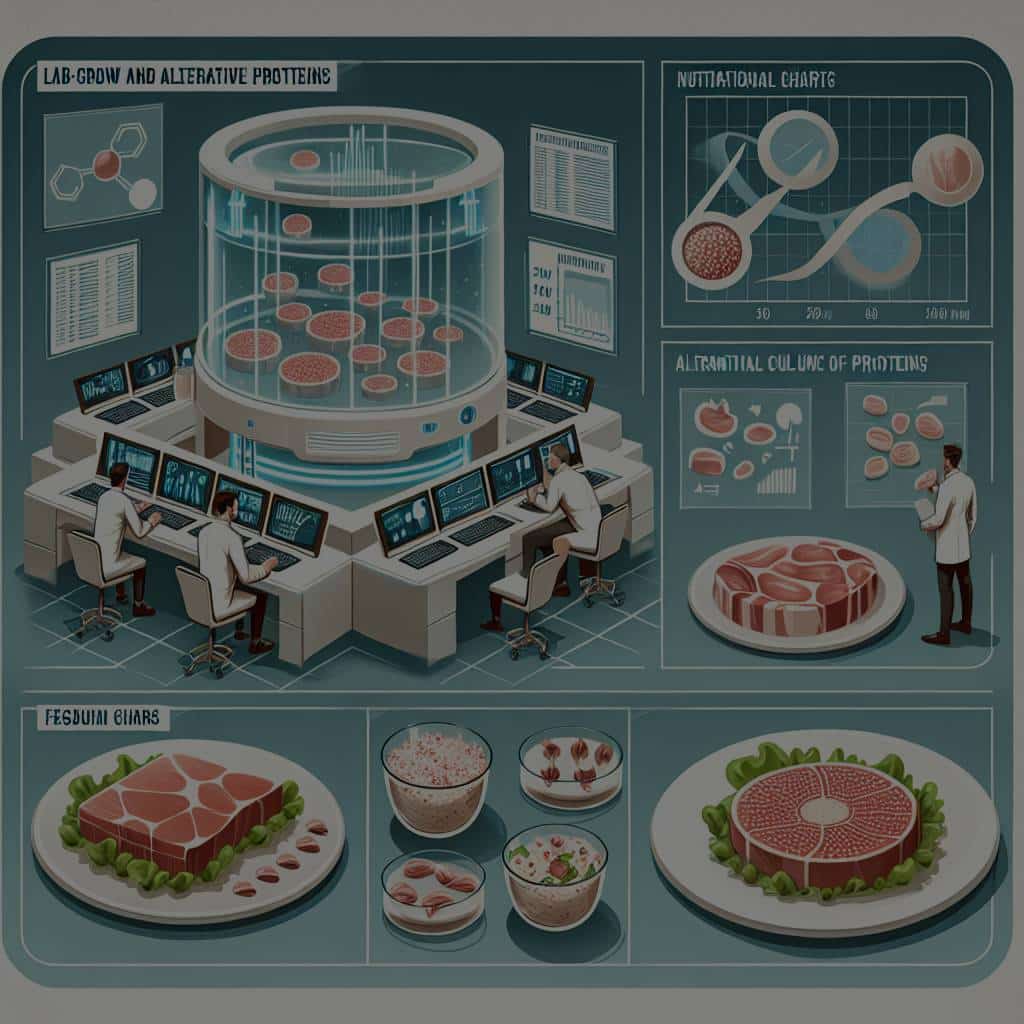What’s the Future of Lab-Grown Meats and Alternative Proteins?

The concept of lab-grown meats and alternative proteins might seem like a script yanked out of a science fiction movie. But you’ll be surprised, this phenomenon is gradually unfolding into our reality. In the quest for sustainable food production, scientists and food enthusiasts alike have turned their focus to novel methods such as cell-based meat and plant-based proteins. Such developments present an alternative path to the traditional animal farming methods that have been the backbone of our diets for centuries. How these alternatives are crafted, their potential benefits, and the foreseeable challenges, will be the focus of this discourse.
The Science of Cultivated Meats
Cell-based or lab-grown meats, as the name suggests, are not derived from animals bred in the open fields or cooped up in industrial farming facilities. These types of meats are cultivated from animal cells in a controlled laboratory environment.
Also to discover : How Can Digital Wallets and Fintech Apps Enhance Financial Inclusion?
In the process of producing cultured meat, scientists start by taking a small sample of animal cells, which can be obtained painlessly from a live animal. The types of cells that are most commonly used are muscle cells. These cells are then placed in a culture media, a nutrient-rich solution that mimics the conditions inside an animal’s body, coaxing the cells to grow and multiply.
As cells feed on this nutrient-rich media, they proliferate and form muscle tissue, which eventually matures into meat. The process is similar to how animals grow their muscles, but everything takes place outside the animal’s body, in a sterile, diet-controlled environment.
Also to discover : What’s the Impact of Social Robotics on Enhancing Learning for Autistic Children?
This method of meat production, although still in its infancy, offers potential benefits over traditional livestock farming, especially in terms of sustainability and animal welfare.
A Greener Alternative to Traditional Livestock Farming
Calling lab-grown meats a greener alternative to traditional livestock farming isn’t just a catchy marketing slogan. It is a statement backed by scientific data and environmental analysis.
Traditional livestock farming accounts for a significant amount of global greenhouse gas emissions. It also uses an extensive amount of land and water resources. The cultivation of animal cells for meat production in the laboratory, however, significantly reduces these environmental impacts.
Lab-grown meat production uses less land and water compared to traditional animal farming. Moreover, it results in considerably lower greenhouse gas emissions. It’s a game-changer for the sustainable food production movement and can potentially alleviate the environmental strain caused by the ever-growing global demand for meat.
The Role of Alternative Proteins
While lab-grown meats are making waves in the industry, plant-based proteins are not left behind either. They represent a significant part of the future of food as they provide a viable and sustainable source of protein.
Plant-based proteins are derived from a variety of sources such as soy, peas, and other legumes, as well as algae and fungi. These proteins are combined and manipulated in different ways to resemble the taste, texture, and nutritional profile of animal-based meats.
More and more companies are investing in research and development of these products, seeking to perfect the taste and texture to satisfy the palate of even the most discerning meat lovers. The rising acceptance and demand for plant-based proteins indicate that they will play a pivotal role in our dietary future.
The Challenges Faced by the Cultured Meat Industry
Despite the potential benefits and promising future of lab-grown meats and alternative proteins, the industry faces some significant challenges.
Cost is a major barrier for cultured meat. The first lab-grown burger, which was produced in 2013, cost a whopping $325,000 to create. Although the cost has dropped significantly over the years, it is still high compared to traditional meat.
Another challenge is scaling up production to meet potential market demand. Currently, the production process of lab-grown meat is meticulous and gentle, not designed for mass production.
Moreover, there are regulatory hurdles to navigate. In many countries, laws governing the sale and marketing of lab-grown meat are still being formulated. It’s a long, complex process that’s likely to delay the wide-scale availability of these products.
The Market Response to Lab-Grown Meat and Alternative Proteins
Despite the challenges, the market response to lab-grown meat and alternative proteins is generally positive, with consumers showing an increased interest in these innovative food products.
The commercial success of plant-based products from companies like Beyond Meat and Impossible Foods signals a shift in consumer behavior and a growing acceptance of alternative proteins. Similarly, in a market survey, a significant proportion of consumers expressed a willingness to try cultured meats once they are available on the market.
The future of lab-grown meats and alternative proteins, while not without challenges, is promising. As the technology progresses, the cost decreases, and the environmental benefits are realized, we are likely to see these products become a significant part of our food system. The future of food is being reimagined, and it’s happening right inside our labs and fields. The anticipation is mouth-watering, to say the least.
The Application of Stem Cells and Cell Lines in Cultured Meat Industry
The utilization of stem cells and cell lines in the cultured meat industry is a complex but fascinating process. This process makes it possible for lab-grown meat to go beyond being a mere concept and become a tangible reality.
Stem cells, as we know, have the ability to differentiate and form specialized cell types. In the context of lab-grown meat, these cells provide the starting point for creating various types of meat products. Scientists typically extract stem cells from a small tissue biopsy taken from a live animal. These stem cells are then placed into a culture media, rich in nutrients and growth factors, wherein they grow and proliferate.
When these cells multiply enough, they are induced to form muscle cells. In some cases, other cell types such as fat cells may also be cultivated, which contribute to the taste and texture of the meat.
On the other hand, cell lines are cells that have been adapted to grow indefinitely in culture media. While utilizing stem cells in meat production can sometimes be unpredictable due to their potential to differentiate into various cell types, cell lines tend to be more predictable and manageable in a laboratory setting.
This process of using stem cells and cell lines to produce cultured meat is a breakthrough. However, it must be noted that the ability to scale this process on a large scale while maintaining quality, taste, and texture equivalent to conventional meat, still remains a challenge.
The Role of Consumer Perception and Acceptance to the Future of Lab-Grown Meats and Alternative Proteins
Consumer perception and acceptance are key factors in determining the future of lab-grown meats and alternative proteins. With based meat increasingly making its way into the mainstream, it is not enough for these products to simply exist – consumers need to be willing to incorporate them into their diets.
Recent studies show a growing interest among consumers towards these products, driven by factors like sustainability, animal welfare, and health. However, it’s worth noting that perception varies greatly among different demographics. Age, level of education, and familiarity with the technology all play a part in shaping consumer attitudes towards lab-grown meat and plant-based proteins.
So, how can the meat industry bridge the divide and encourage wider acceptance of these products? Education seems to be a key factor. The more consumers understand about the processes involved in producing lab-grown meat and plant-based proteins, the more comfortable they may feel about consuming them.
Moreover, marketing strategies that emphasize the environmental and animal welfare benefits, as well as the potential health benefits, may help sway the consumers who remain unsure about these products. Price and taste, of course, will also be significant deciding factors.
Conclusion
The future of lab-grown meats and alternative proteins is a fascinating one, ripe with potential benefits and innovations. From the science of cultivating animal cells in a lab to the development of tasty and satisfying plant-based proteins, the industry is poised to revolutionize the way we approach food production and consumption.
Despite the challenges ahead, including high production costs and regulatory hurdles, the shifting consumer perception and growing market acceptance indicate a promising future for this industry. As the technology improves and becomes more affordable, it’s likely that lab-grown meat and alternative proteins will become a more common sight on our dinner plates.
Indeed, the possibilities are immense. The journey to a more sustainable, ethical, and health-conscious food system has already begun, and it’s exciting to consider where we might be in the near future. As the curtain rises on this new era of food, one thing is certain – the future of food is looking less like a science fiction movie and more like a reality unfolding right before our eyes.
